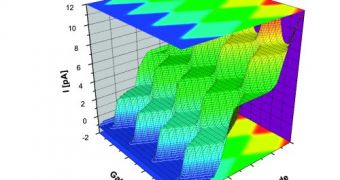The ampere is one of the seven base units of the International System of Units, and while it is one of the electric units, its definition does not directly tie it to the others. Therefore, the ampere is the electrical constant current, circulated through two parallel infinite conductors placed in void, at a distance of one meter apart, which would produce a force equal to 2?10-7 newton in strength. One ampere is equal to once coulomb of electric charge flowing through the section of the conductor every second.
However, while most measuring methods involve determining high currents with relative high accuracy, measuring low intensity currents such as those used in microdevices is proving to be somehow problematic. In order to design better methods of accurately measuring low intensity currents, a collaboration between physicists from Finland and the U.S. led to the developing of the smallest electronic device, created from a single electron transistor that can be successfully used to measure currents by converting an oscillating voltage.
Similar devices capable of delivering a single electron at a time have been experimented over the years, however, they all ended up in failure. The device developed by Jukka Pekola, from the Helsinki University of Technology, consists of a small conducting material, which is connected to two tunnel junctions, through which electrons flow by controlling the voltage through a gate electrode connected to the conducting material.
A tunnel junction represents the smallest and simplest insulating layer between two conducting materials. Due to the fact that the tunnel junctions are so small, it presents a strong quantum mechanical effect that prevents more than an electron to tunnel through the structure at one time.
However, the quantum effects that take place in the tiny device also greatly amplify the thermal parasite signals to interfere with the transistor. In order to resolve this problem, the scientists cooled the device at a temperature of 0.1 Kelvin, thus when a oscillating voltage is applied, it will only permit the passing of a precise number of electrons at a time.
By determining the number of electrons which flow through the transistor, and by multiplying that with the charge and the frequency of the oscillating voltage, scientists have been able to determine the precise intensity of the current passing through it.
So far, Pekola was able to determine currents of about 100 pico-Ampere, by mounting in parallel multiple such devices, which makes it one of the best candidates for creating a so-called 'metrological current pump' that could be used to clearly define the Ampere, through the measuring of the Voltage and frequency of a specific flowing through a conductor.

 14 DAY TRIAL //
14 DAY TRIAL //